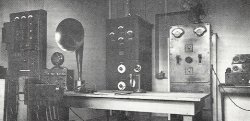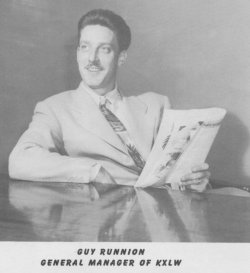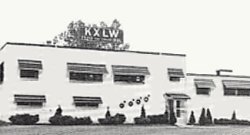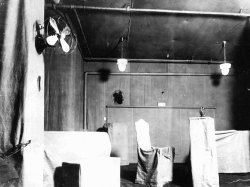Station KSD, the St. Louis Post-Dispatch [station], can truthfully be said to have put St. Louis on the radio map.
It was the first broadcasting station in the United States to be authorized to transmit on a wave length of 400 meters. Since then 24 other stations of this class have been licensed and in addition there are nearly 600 stations of smaller capacity. By right of priority Station KSD is entitled to rank as a pioneer in the broadcasting field, and today there is no more powerful privately owned station in the United States, for KSD in transmitting its daily market reports and its nightly concerts is using the maximum of power which the government permits to be used in broadcasting.
It is a station of the first class of which St. Louis is proud, for it is doubtful if any other agency has been, or ever could be so effective in spreading the fame and good name of St. Louis in far away places. This is national and international advertising the cost of which through any other medium would stagger the imagination.
Through Station KSD the name of St. Louis has been carried into every city and town and practically every village and hamlet in the 48 states of the Union. It was the first broadcasting station to be heard in the period of a single night in all the 48 states and by ships on the Atlantic and Pacific oceans. It has carried the name of St. Louis into all the provinces of Canada and into Alaska, Cuba, Mexico, Porto (sic) Rico, Guadaloupe, Bermuda, Honduras, Nicaragua and Peru.
At the time of this writing the KSD long distance record of transmission is 4008 miles. This record was made when a midnight concert sent out from the station was heard on Akun Island of the Aleutian Island group off the Alaskan coast the night of Jan. 1 of this year. The island of Akun is one of the world’s lonely spots, given over mainly to sulphur mining. It is 2068 miles northwest of San Francisco, 1700 miles from Seattle and on almost the same longitude line as the eastern coast of Asia.
Even more startling, because of the greater difficulty in reaching the warm countries to the south by radio, was the establishing of KSD’s farthest south record the night of Jan. 25 when a program broadcast from this station was heard on a ship in the Pacific Ocean 2000 miles off the coast of Peru, 840 miles south of the equator and 3744 miles south of St. Louis.
The station’s daylight transmission record to the time of this writing was made when its broadcasting of market reports was heard in West Brookfield, Mass., approximately 1000 miles from the sending instrument. This is considered remarkable in view of the known fact that radio transmission never carries as far in the daytime as at night.
It is in this daylight transmission that KSD performs a service of the greatest practical value which would amply justify its existence even if it did not supplement this service by providing nightly entertainment and instruction for many thousands of listeners in on its concerts.
Those who think of a broadcasting station merely as a disseminator of music and addresses to beguile the hours between dinner and bedtime have only a very inadequate concept of its scope and usefulness. The Post-Dispatch radio station might almost be called a “radio newspaper.” It is “on the air” by day as well as by night. Market information of every kind of interest to the great Mississippi Valley is broadcast hourly. In hundreds of towns this information is received in banks, mills, stores and public schools and posted on bulletin boards for the information of the local public. In many cases the market quotations received by radio are relayed on local telephone lines. At each hour of transmission general news items are also broadcast.
The extent, quality and value of the daylight market service was strikingly shown in the first of January this year when the United States Department of Agriculture made a survey and invited letters from those interested in market reports as to the value of the market broadcasting service given by the radio stations. An official tabulation of the returns from a large section of the east and middle west showed that in 60 percent of the letters in which the writers referred to specific stations, the station which they named was KSD. There was a great preponderance of opinion that the broadcasting service was of the highest value to farmers and merchants in all parts of the country.
An idea of the extensiveness of this service can be had by consulting the following schedule of KSD daily broadcasting: 9:40 a.m. Opening St. Louis grain quotations. Liverpool first cables on wheat. Estimated receipts of livestock and opening hog markets of National Stockyards, Ill., and Chicago. 10:40 a.m. St. Louis future grain quotations. Liverpool second cables on wheat. Receipts and shipments of grain by cars in St. Louis. Midsession livestock market report from National Stockyards, Ill. New York opening cotton market. New York opening stock and bond markets. Liverpool opening cotton quotations. Weather forecasts for St. Louis and vicinity, Illinois, Iowa and shippers’ forecast. River forecasts and stages. 11:40 a.m. St. Louis future grain quotations. Liverpool closing cables on wheat. St. Louis hay market quotations. 12:40 p.m. St. Louis future grain quotations. Poultry, egg and butter market quotations. Weather forecasts for St. Louis, Illinois, Iowa. River forecasts and stages. 1:40 p.m. St. Louis closing future grain prices. Closing prices on cash grain, horses and mules. 2:40 p.m. Closing livestock report from National Stockyards, Ill. 4:00 p.m. New York closing quotations on cotton. New York closing stock exchange. Information Bulletins from the U.S. Department of Commerce and Agriculture. New York metal quotations.
The usefulness of KSD in the public service does not end with the going down of the sun. Its nightly programs have been a delight to a whole continent. For entertainment quality alone they are entitled to the first rank. This station, unlike some others, has not confined itself to jazz programs and the lighter forms of music. While not overlooking the diversional (sic) value of such music, which at times it presents in its best accepted form, Station KSD has aimed for the predominance of high class music interpreted by the best performers available. In this way it is doing its full share in the effort to disseminate a taste for good music. Its broadcasting of the Saturday night concerts of the St. Louis Symphony Orchestra is a weekly event that is looked forward to in thousands of homes scattered throughout the United States. Last season it broadcasted the Municipal Opera in Forest Park and it is planning to repeat this in the coming summer season. A notable event was its broadcasting of the entire operas Aida and Cavalleria Rusticana from the Odeon when the San Carlo Opera Company sang there in January.
The broadcasting of the midnight Mass from the Old Cathedral last Christmas Day, lasting two hours, was the station’s greatest achievement in musical transmission. All over the country it was hailed as the most perfect and most inspiring offering of its kind ever sent out over the radio.
High class concerts by bands and orchestras, oratorios and numbers by noted choral clubs and choirs are a frequent source of delight to this station’s great and far-flung audience.
The spirit of service to the public is always apparent in the evening programs. An instance in point was the tremendously valuable aid given by Station KSD in the recent bond issue campaign in St. Louis. Each week the program included addresses by some prominent citizen or official in favor of one or more of the 21 propositions to be voted on. The ground was thoroughly covered, and there can be no doubt that the vigorous campaign made by KSD over the radio played no small part in the success of the bond issue propositions, as a result of which St. Louis will expend $87,000,000 on public improvements.
The programs also have included a series of popular lectures by members of the St. Louis Medical Society and addresses by St. Louisans on the attractions of the city, as a convention city on the superiority and attractiveness of its playgrounds, parks, art museum and zoo. There also have been popular science talks by noted authorities and addresses by distinguished visitors to the city.
The mail is a great index to the usefulness of any business or nay service. Though the station asks for letters only from those at a long distance, every mail brings letters of appreciation for the great work done by the station in service and entertainment. Just to give an idea of the range of this correspondence it may be said that the station’s mail each week will show letters from every state in the Union, that the daily programs of the station are now printed – at least in condensed form – in newspapers in 82 cities, and that letters of appreciation have been received from almost every city and town of 5000 or more in the United States and Canada and thousands of towns have been heard from. For instance, every city, town and hamlet which appears on the map of New Jersey is represented in the mail KSD has received; 180 different cities and towns in Pennsylvania, 78 in Massachusetts and more than 100 cities in California have listeners-in who have written to KSD to say in effect: “Great work; Keep it up!”
Originally published in Greater St. Louis magazine March 1923)




